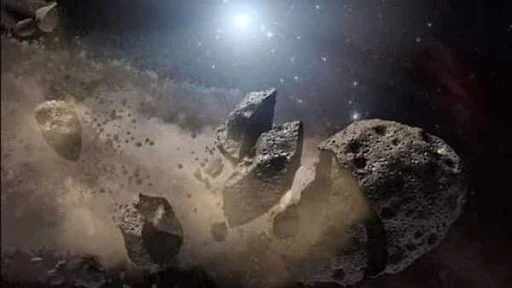Space is full of surprises and dangers. Every day, a number of asteroids come close to Earth, but only a small portion of them pose a risk to humanity. However, risk has just skyrocketed. NASA has issued a warning regarding two hazardous asteroids that are set to approach Earth closely in the coming week.
What are these asteroids and how big are they?
The first asteroid, known as 1994 XD, is an enormous 1500-foot object, roughly the size of a bridge, moving at an astonishing speed of 77301 kilometres per hour. Its closest proximity to Earth will be on June 12.
The second asteroid, named 2020 DB, is even larger than the previous one and will reach its closest distance to Earth on June 15. This colossal rock measures a staggering 1600-foot and is currently hurtling towards us at a rapid pace of 34279 kmph.
To put things in perspective, these asteroids are bigger than most buildings on Earth. For comparison, the Empire State Building in New York is about 1250 feet tall¹. Imagine the impact of such massive objects hitting our planet!
How close will they come to Earth and are they dangerous?
The main concerns of these asteroids are – the proximity of asteroids to Earth and their gigantic size. As per NASA's asteroid data tracking webpage, asteroid 1994 XD will approach Earth at a distance of merely 1.97 million miles. On the other hand, asteroid 2020 DB is set to come as close as 2.68 million miles.
The Jet Propulsion Laboratory's Center for NEO Studies maintains a list of near-Earth objects that are likely to make close approaches to Earth in order to detect any potential dangers ahead of time. NASA's JPL has classified all space rocks that come within 4.6 million miles of Earth and have a size greater than approximately 150 meters as "potentially hazardous objects." This classification allows for the monitoring and assessment of objects that could pose a risk to our planet.
Consequently, these asteroids are identified as "potentially hazardous objects." Although the distance between these asteroids and Earth is considerable, but even a minor deviation from their trajectory due to the gravitational influence of a planet can redirect them towards Earth. Such a scenario could lead to an unimaginably catastrophic impact!
How does NASA track these asteroids and what can we do about them?
NASA uses various technologies, such as telescopes and satellites, both on Earth and in space, to monitor these asteroids. Planetary radar, conducted by radio telescopes at NASA's Deep Space Network and the National Science Foundation's Arecibo Observatory in Puerto Rico, provides some of the most detailed characterization data for NEOs that come close enough to Earth to be observed.
NASA also has several missions planned or underway to study asteroids and test methods to deflect them if needed. For example, the Double Asteroid Redirection Test (DART) mission will attempt to change the orbit of a small moonlet around a larger asteroid by crashing into it in late 2022. The Asteroid Impact and Deflection Assessment (AIDA) mission will follow up on DART's results by measuring the change in orbit and other properties of the asteroid system.
These missions are part of NASA's Planetary Defense Coordination Office (PDCO), which is responsible for coordinating efforts to protect Earth from hazardous asteroids and comets. The PDCO also works with other agencies and organizations around the world to share information and collaborate on strategies for planetary defense.
While we cannot prevent asteroids from existing or approaching Earth, we can be prepared for them and take action if necessary. As NASA says, "knowing the facts is the first step in preventing an asteroid impact disaster."
Conclusion
Asteroids are fascinating objects that can teach us a lot about the history and formation of our solar system. However, they can also pose a serious threat to our planet if they come too close or collide with us. That's why NASA and other agencies are constantly monitoring and studying these space rocks and developing ways to deal with them. As citizens of Earth, we should also be aware of the potential dangers and support the efforts to protect our home planet from asteroid impacts.
Source:








